- Accueil
- Pages cachées
- 21 AOUT 2023 NEWS
21 AOUT 2023 NEWS
INSTITUT SUPERIEUR D'ANTHROPOLOGIE
INSTITUTE OF ANTHROPOLOGY
ONLINE COURSES / COURS A DISTANCE
DEBUT COURS :SEPTEMBRE 2023
REGISTER NOW
KOSOVO – 
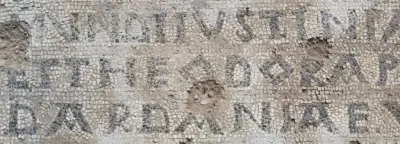 Ulpiana - A mixed team of international and local experts led by Professor Christophe J. Goddard has unearthed a monumental inscription of historical importance, dedicated to the Byzantine Emperor Justinian, at the archaeological site of Ulpiana during excavations. This inscription dedication by Emperor Justinian (527-565 AD) and his wife Theodora of an ‘Urbem Dardania,’ which means ‘city in Dardania, is one of the very few Latin dedications of the imperial couple in the late Roman world. Ulpiana is a Roman-Illyrian city. Archaeological excavations have taken place there since 1954. Traces of pre-Roman life were discovered during archaeological excavations from 2009 to 2011. Ulpiana was an important place for the Dardan Kingdom. Was inhabited and that the area was inhabited by the Dardan and Illyrians during the Classical period. The unearthing of this mosaic, as well as the discovery of an imposing episcopal basilica in 2022, are the concrete results of an EU-funded project titled “The European Archaeological Mission in Kosovo*: from Ulpiana to Iustiniana Secunda”, which is expected to conclude in December 2024. The inscription of Emperor Justinian is considered the most important discovery in Kosovar archaeology. Photo: Minister of Culture, Youth, and Sports of the Republic of Kosovo, Hajrulla Çeku / Facebook According to archaeologists, this provides evidence of the Dardanian origin of the great Byzantine emperor. Emperor Justinian (527-565) was born in Tauresium, believed to be near present-day Skopje. Arben Hajdari, Professor of Archaeology at the University of Prishtina, stated to BIRN that this inscription holds immense historical weight, representing the most significant findings ever in Kosovo’s archaeology. Hajdari emphasized that a crucial element of the inscription is the mention of the city of Dardania, indicating that the Dardanian people did not Romanize and did not lose their identity. “This is very important, considering the fact that archaeological literature has invested a lot, with many articles and studies attempting to argue that the Dardanians had lost their identity, were Romanized, and disappeared in the Middle Ages. This discovery holds great significance from this perspective,” he explained. The inscription extends through the central part of the basilica, and the researchers have conducted excavations over an area of more than 460 square meters, identifying various ornamentations with floral and faunal motifs. “The inscription left us astonished because it is preserved in a way that seals the fact that we are indeed dealing with a Dardanian city, built by an emperor of Dardanian origin,” said Milot Berisha, the head of the Archaeological Park “Ulpiana” and archaeologist.
Ulpiana - A mixed team of international and local experts led by Professor Christophe J. Goddard has unearthed a monumental inscription of historical importance, dedicated to the Byzantine Emperor Justinian, at the archaeological site of Ulpiana during excavations. This inscription dedication by Emperor Justinian (527-565 AD) and his wife Theodora of an ‘Urbem Dardania,’ which means ‘city in Dardania, is one of the very few Latin dedications of the imperial couple in the late Roman world. Ulpiana is a Roman-Illyrian city. Archaeological excavations have taken place there since 1954. Traces of pre-Roman life were discovered during archaeological excavations from 2009 to 2011. Ulpiana was an important place for the Dardan Kingdom. Was inhabited and that the area was inhabited by the Dardan and Illyrians during the Classical period. The unearthing of this mosaic, as well as the discovery of an imposing episcopal basilica in 2022, are the concrete results of an EU-funded project titled “The European Archaeological Mission in Kosovo*: from Ulpiana to Iustiniana Secunda”, which is expected to conclude in December 2024. The inscription of Emperor Justinian is considered the most important discovery in Kosovar archaeology. Photo: Minister of Culture, Youth, and Sports of the Republic of Kosovo, Hajrulla Çeku / Facebook According to archaeologists, this provides evidence of the Dardanian origin of the great Byzantine emperor. Emperor Justinian (527-565) was born in Tauresium, believed to be near present-day Skopje. Arben Hajdari, Professor of Archaeology at the University of Prishtina, stated to BIRN that this inscription holds immense historical weight, representing the most significant findings ever in Kosovo’s archaeology. Hajdari emphasized that a crucial element of the inscription is the mention of the city of Dardania, indicating that the Dardanian people did not Romanize and did not lose their identity. “This is very important, considering the fact that archaeological literature has invested a lot, with many articles and studies attempting to argue that the Dardanians had lost their identity, were Romanized, and disappeared in the Middle Ages. This discovery holds great significance from this perspective,” he explained. The inscription extends through the central part of the basilica, and the researchers have conducted excavations over an area of more than 460 square meters, identifying various ornamentations with floral and faunal motifs. “The inscription left us astonished because it is preserved in a way that seals the fact that we are indeed dealing with a Dardanian city, built by an emperor of Dardanian origin,” said Milot Berisha, the head of the Archaeological Park “Ulpiana” and archaeologist.
ISRAEL – 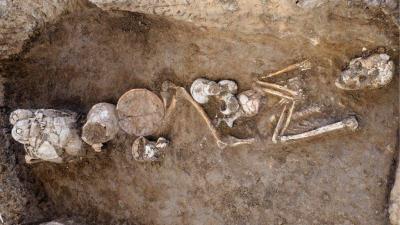 Tel Yehud - Opium traces found at an ancient Israeli burial site might have been offerings to gods, according to recent research. Archeologists analyzed residue left in eight out of twenty-two vessels discovered amongst the remains and dated it back to approximately the 14th century B.C. This would have been the late Bronze Age. Israel has been the location of many exciting recent discoveries, including the Temple of Solomon. Opium lined the clay vessels that lay in the grave of a forty to fifty-year-old male located in the region of Tel Yehud, once called Canaan. The site was unearthed in 2012 while the grave was discovered in 2017, but the findings were only published in July 2022 in the scientific journal Archaeometry. Several of the vessels were in the shape of the inverted flower and, interestingly enough, some evidently came from Cyprus. These latest findings which came about following research conducted by Israel Antiquities Authorities ( IAA), Tel Aviv University, and The Weizmann Institute of Science, have helped historians attain a clearer perspective of the opium trade in the orient and the Cypriot base-ring juglets used to store it. Traders brought the opium over from Anatolia via Cyprus, where craftsman then created the receptacles to house the drug. Some believe the juglets were part of ritualistic services, which makes the find significant for two reasons. First of all, it confirms the theory that narcotics played an integral part in religious rituals. Participants might have used it to induce an ecstatic state that allowed family members to commune with departed relatives. They could also have placed it in the graves, however, to aid the deceased in their ascent to the heavens. The second reason it is a significant find is that it traces the opium trade from Anatolia to Cyprus to Israel over 3,400 years ago. Indeed, the discovery of the pottery in Israel and other locations like Syria and Lebanon proves that the island conducted a flourishing trade.
Tel Yehud - Opium traces found at an ancient Israeli burial site might have been offerings to gods, according to recent research. Archeologists analyzed residue left in eight out of twenty-two vessels discovered amongst the remains and dated it back to approximately the 14th century B.C. This would have been the late Bronze Age. Israel has been the location of many exciting recent discoveries, including the Temple of Solomon. Opium lined the clay vessels that lay in the grave of a forty to fifty-year-old male located in the region of Tel Yehud, once called Canaan. The site was unearthed in 2012 while the grave was discovered in 2017, but the findings were only published in July 2022 in the scientific journal Archaeometry. Several of the vessels were in the shape of the inverted flower and, interestingly enough, some evidently came from Cyprus. These latest findings which came about following research conducted by Israel Antiquities Authorities ( IAA), Tel Aviv University, and The Weizmann Institute of Science, have helped historians attain a clearer perspective of the opium trade in the orient and the Cypriot base-ring juglets used to store it. Traders brought the opium over from Anatolia via Cyprus, where craftsman then created the receptacles to house the drug. Some believe the juglets were part of ritualistic services, which makes the find significant for two reasons. First of all, it confirms the theory that narcotics played an integral part in religious rituals. Participants might have used it to induce an ecstatic state that allowed family members to commune with departed relatives. They could also have placed it in the graves, however, to aid the deceased in their ascent to the heavens. The second reason it is a significant find is that it traces the opium trade from Anatolia to Cyprus to Israel over 3,400 years ago. Indeed, the discovery of the pottery in Israel and other locations like Syria and Lebanon proves that the island conducted a flourishing trade.
https://greekreporter.com/2023/08/19/opium-ancient-burial-site/
TURQUIE - 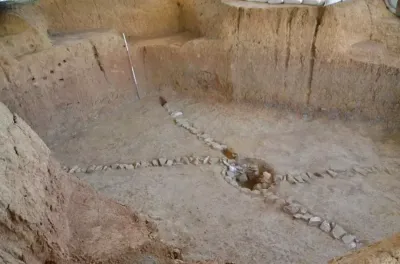 Şapinuva - A 3,500-year-old grain silo has come to light during the archaeological excavations carried out in the Central Anatolian province of Çorum's Şapinuva, which was once the capital of the Hittite Empire and one of the most important religious and military centers. The silo, which has been unearthed in the region called the Workshops District in the Şapinuva ruins, draws attention as it was built on natural soil. Unlike the grain silos in other Hittite cities, the silo was built by being carved into the soil instead of stone at the bottom, while there are channels and a leak well to prevent the grains from getting wet. Professor Önder İpek, the head of the excavations from Hitit University Archeology Department, pointed out that two separate workshop structures were unearthed during the excavations carried out by Aygül Süel in 2014 and said that the workshop structures were among important discoveries in terms of learning the mining technology in the Hittite era. İpek said that crucibles, molds and some metal tools, which are important evidence of mining technology, were found in the workshop, too. İpek stated that the excavations in the ancient city, which is divided into two as Ağılönü, where the holy places are located, and the Tepeinter area, where the administrative structure and warehouses are located, were carried out in recent years in an area they call the "G" area, where the workshops are located. We continue our work in the area on the west side of the Workshop-1 structure. The reason why this place was called the workshop district is that there are more than one workshop. Considering that there may be another workshop structure in the area we are working on, we continued the excavations in this area. The works that started in the region in 2022 continue this year. However, when we finalized the works, we saw that this area was a grain silo. We know that examples of such silos are also found in Hattusa and Alacahöyük. There are also such wheat or grain silos in other Hittite cities. We also know of the existence of such silos in Kaman Kalehöyük and Kuşaklı Höyük in Sivas. Besides the two silos in Ağılönü found in previous years in Şapinuva, we found such a large silo structure carved into the soil this year,” he said. İpek also provided information about the features and technical structure of the silo structure, saying, “One of the main features of the silo is that it is made by carving the main soil. The silo is 10x5 meters in size and positioned at 3.40 centimeters deep. Technically, it does not have a stone-floored structure like the silos in Hattusa and Alacahöyük. The floor of the silo consists of earth instead of stone pavement. In addition, as in the Hattusa and Alacahöyük examples, channels, which are covered with flat stones, are opened from four different directions to evacuate the moisture inside the silo. We see this technique in other Hittite cities as well. In addition, we found that the channels are connected to the leakage well with a certain slope. Some soil samples taken from here are also being examined. Which grain is stored here will also be revealed as a result of our examinations.
Şapinuva - A 3,500-year-old grain silo has come to light during the archaeological excavations carried out in the Central Anatolian province of Çorum's Şapinuva, which was once the capital of the Hittite Empire and one of the most important religious and military centers. The silo, which has been unearthed in the region called the Workshops District in the Şapinuva ruins, draws attention as it was built on natural soil. Unlike the grain silos in other Hittite cities, the silo was built by being carved into the soil instead of stone at the bottom, while there are channels and a leak well to prevent the grains from getting wet. Professor Önder İpek, the head of the excavations from Hitit University Archeology Department, pointed out that two separate workshop structures were unearthed during the excavations carried out by Aygül Süel in 2014 and said that the workshop structures were among important discoveries in terms of learning the mining technology in the Hittite era. İpek said that crucibles, molds and some metal tools, which are important evidence of mining technology, were found in the workshop, too. İpek stated that the excavations in the ancient city, which is divided into two as Ağılönü, where the holy places are located, and the Tepeinter area, where the administrative structure and warehouses are located, were carried out in recent years in an area they call the "G" area, where the workshops are located. We continue our work in the area on the west side of the Workshop-1 structure. The reason why this place was called the workshop district is that there are more than one workshop. Considering that there may be another workshop structure in the area we are working on, we continued the excavations in this area. The works that started in the region in 2022 continue this year. However, when we finalized the works, we saw that this area was a grain silo. We know that examples of such silos are also found in Hattusa and Alacahöyük. There are also such wheat or grain silos in other Hittite cities. We also know of the existence of such silos in Kaman Kalehöyük and Kuşaklı Höyük in Sivas. Besides the two silos in Ağılönü found in previous years in Şapinuva, we found such a large silo structure carved into the soil this year,” he said. İpek also provided information about the features and technical structure of the silo structure, saying, “One of the main features of the silo is that it is made by carving the main soil. The silo is 10x5 meters in size and positioned at 3.40 centimeters deep. Technically, it does not have a stone-floored structure like the silos in Hattusa and Alacahöyük. The floor of the silo consists of earth instead of stone pavement. In addition, as in the Hattusa and Alacahöyük examples, channels, which are covered with flat stones, are opened from four different directions to evacuate the moisture inside the silo. We see this technique in other Hittite cities as well. In addition, we found that the channels are connected to the leakage well with a certain slope. Some soil samples taken from here are also being examined. Which grain is stored here will also be revealed as a result of our examinations.
https://www.hurriyetdailynews.com/ancient-grain-silo-found-in-sapinuva-185587
TURQUIE - 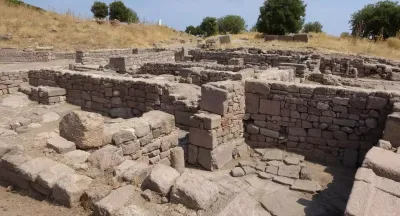 Assos - Archaeological excavations that have been carried out in the ancient city of Assos in the Ayvacık district of the southern province of Çanakkale bring new finds. Works in the Roman-era Nymphaeum (Monumental Fountain) in the east of the Agora, a third century B.C. weight unit, which was made of lead, has been unearthed. Weighing 320 grams, the weight unit was the largest one to date, officials reported. There is a depiction of the Gryphon, a mythological creature used on the city's coins, on the scales. Officials also reported that in some of the weight units, the name of the city was written with the abbreviation “ASS.” Noting that excavations continue in a Roman-era fountain on the eastern edge of the Agora, Arslan said, “Our work here is not finished yet. However, since the space between this fountain and the main rock was used as a garbage dump in the third and fourth centuries, it provides important data for archaeological research. We shared some finds that were found here last year. In the same area - in Late Roman-era Assos, it was seen that cattle bones were more abundant among the pots and pans used in daily life as well as small terracotta figurines used in religious rituals, tableware and various animal bones used especially for nutrition. It was determined that animals such as pigs, goats and sheep were consumed by people. There are also pigs and other animals. More precise data will be obtained after the reports of experts on this subject.” Arslan stated that they found the weight unique to the city of Assos in the space used as a garbage dump between the fountain and the main rock in the fountain structure, adding, “It is a weight unique to the city of Assos; it is made of lead. In ancient times, each city had its own weight units. Weights were used especially in commerce or for weighing something. The weight of the city of Assos includes a mythological animal called the gryphon. The same were also found in tombs from the Hellenistic period. But their weight was less. This weight unit is heavier than any samples we have found so far, which is weighing about 320 grams.”
Assos - Archaeological excavations that have been carried out in the ancient city of Assos in the Ayvacık district of the southern province of Çanakkale bring new finds. Works in the Roman-era Nymphaeum (Monumental Fountain) in the east of the Agora, a third century B.C. weight unit, which was made of lead, has been unearthed. Weighing 320 grams, the weight unit was the largest one to date, officials reported. There is a depiction of the Gryphon, a mythological creature used on the city's coins, on the scales. Officials also reported that in some of the weight units, the name of the city was written with the abbreviation “ASS.” Noting that excavations continue in a Roman-era fountain on the eastern edge of the Agora, Arslan said, “Our work here is not finished yet. However, since the space between this fountain and the main rock was used as a garbage dump in the third and fourth centuries, it provides important data for archaeological research. We shared some finds that were found here last year. In the same area - in Late Roman-era Assos, it was seen that cattle bones were more abundant among the pots and pans used in daily life as well as small terracotta figurines used in religious rituals, tableware and various animal bones used especially for nutrition. It was determined that animals such as pigs, goats and sheep were consumed by people. There are also pigs and other animals. More precise data will be obtained after the reports of experts on this subject.” Arslan stated that they found the weight unique to the city of Assos in the space used as a garbage dump between the fountain and the main rock in the fountain structure, adding, “It is a weight unique to the city of Assos; it is made of lead. In ancient times, each city had its own weight units. Weights were used especially in commerce or for weighing something. The weight of the city of Assos includes a mythological animal called the gryphon. The same were also found in tombs from the Hellenistic period. But their weight was less. This weight unit is heavier than any samples we have found so far, which is weighing about 320 grams.”
https://www.hurriyetdailynews.com/excavations-in-assos-reveal-new-finds-185566
BULGARIE – 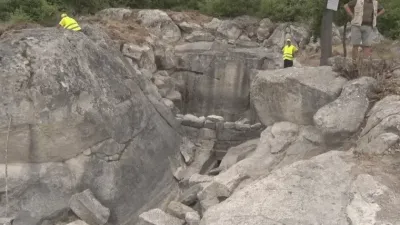 Perperikon - New researchs uncovered a huge monumental sanctuary of water (Nymphaeum) above the reservoir in the southern quarter of Perperikon. Professor Nikolay Ovcharov, head of the excavation of the archaeological complex, told reporters that it is a Nymphaeum from 2-3 centuries. Perperikon, an archaeological complex located at an altitude of 470 meters near the city of Kardzhali, Bulgaria, in the Eastern Rhodopes, is considered one of the oldest megalithic monuments. Until now, it was believed that there was only a water reservoir on the site. Recent excavations show that there was a sanctuary with a beautiful wall and columns from the Roman period. Nymphaeums were sanctuaries for water nymphs. It was an elaborately decorated public drinking fountain – a semicircular monumental Classical fountain house. It often had niches filled with sculpture. The nymphaeum served as a sanctuary, a reservoir, and an assembly chamber where weddings were held. Professor Nikolay Ovcharov said that the area, which is one of the longest-studied areas of Perperikon, has so far only been considered a reservoir with a drinking water volume of close to half a million liters and a depth of about 5 meters. It was the new discoveries during the current restoration project of the site that led archaeologists to conclude that the water temple existed. It turned out that this cistern, unlike the cistern on the Acropolis, which was completely cut into the rocks, here was cut on only three sides. On the east side, it has a beautiful, very well-made square wall, which, as it turned out, was actually the facade of this facility. In the excavations, we found parts of cornices, pedestals of columns, bases of columns, and perhaps also of statues, explained Prof. Ovcharov. In his statement, Ovcharov emphasized the importance of urban nymphaeums, especially during the siege periods, and pointed out that such examples exist in Asia Minor, but similar artifacts of glorification and deification of water are rare in Bulgaria.
Perperikon - New researchs uncovered a huge monumental sanctuary of water (Nymphaeum) above the reservoir in the southern quarter of Perperikon. Professor Nikolay Ovcharov, head of the excavation of the archaeological complex, told reporters that it is a Nymphaeum from 2-3 centuries. Perperikon, an archaeological complex located at an altitude of 470 meters near the city of Kardzhali, Bulgaria, in the Eastern Rhodopes, is considered one of the oldest megalithic monuments. Until now, it was believed that there was only a water reservoir on the site. Recent excavations show that there was a sanctuary with a beautiful wall and columns from the Roman period. Nymphaeums were sanctuaries for water nymphs. It was an elaborately decorated public drinking fountain – a semicircular monumental Classical fountain house. It often had niches filled with sculpture. The nymphaeum served as a sanctuary, a reservoir, and an assembly chamber where weddings were held. Professor Nikolay Ovcharov said that the area, which is one of the longest-studied areas of Perperikon, has so far only been considered a reservoir with a drinking water volume of close to half a million liters and a depth of about 5 meters. It was the new discoveries during the current restoration project of the site that led archaeologists to conclude that the water temple existed. It turned out that this cistern, unlike the cistern on the Acropolis, which was completely cut into the rocks, here was cut on only three sides. On the east side, it has a beautiful, very well-made square wall, which, as it turned out, was actually the facade of this facility. In the excavations, we found parts of cornices, pedestals of columns, bases of columns, and perhaps also of statues, explained Prof. Ovcharov. In his statement, Ovcharov emphasized the importance of urban nymphaeums, especially during the siege periods, and pointed out that such examples exist in Asia Minor, but similar artifacts of glorification and deification of water are rare in Bulgaria.
https://arkeonews.net/a-nymphaeum-was-discovered-in-the-ancient-thracian-city-of-perperikon/
ITALIE – 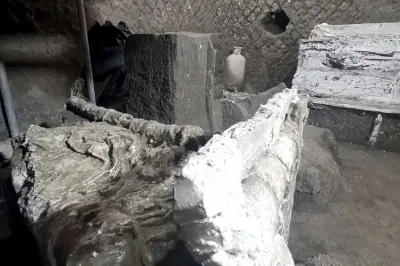 Pompéi - Archaeologists have discovered a small bedroom in Civita Giuliana villa near Pompeii that was almost certainly used by slaves, throwing light on their lowly status in the ancient world, Italy’s Culture Ministry said on Sunday. The room found at the Civita Giuliana villa contained two beds, only one of which had a mattress, two small cabinets, urns, and ceramic containers, in which the remains of two mice and a rat were found. The room was found at the villa, some 600 meters (2,000 feet) north of the walls of Pompeii, which was wiped out by a volcanic eruption of Mount Vesuvius nearly 2,000 years ago. “These details once again underline the conditions of precarity and poor hygiene in which the lower echelons of society lived during that time,” the culture ministry said in its statement. Materials such as furniture and fabric decomposed over time after being covered by the devastating blast of rock fragments, gas, and ash from Vesuvius, leaving a void in the debris. When the plaster is used to fill the void, it reveals the original shape and contours of the long-gone material, including the outline of a crumpled blanket left on the bed netting. No traces were found of grates, locks, or chains to restrain the room’s inhabitants.“It seems that control was primarily exerted through the internal organization of servitude, rather than physical barriers and restraints,” said Gabriel Zuchtriegel, the director of the Archaeological Park of Pompeii. The new room, called “room “A”, is different from the one already known as room “C”, rebuilt in November 2021 in which three cots were positioned and which served at the same time as a closet. What has now emerged suggests a precise hierarchy within the servitude. While one of the two beds found in recent weeks is of the same invoice, extremely simple and without a mattress, as those of 2021, the other is of a more comfortable and expensive type, known in the bibliography as a “spalliera bed”. Traces of red decorations on two of the backs are still visible in the cinerite. In addition to the two beds, in the recently excavated room there are two small wardrobes, also partially preserved as casts, a series of amphorae and ceramic vases and various tools, including an iron hoe. The micro-excavation of vases and amphorae from room “C” has in the meantime revealed the presence of at least three rodents: two mice in an amphora and a rat in a jug, positioned under one of the beds and from which it seems that the animal tried to escape when he died in the pyroclastic flow of the eruption. Details that once again underline the conditions of precariousness and hygienic discomfort in which the last of the society of the time lived.
Pompéi - Archaeologists have discovered a small bedroom in Civita Giuliana villa near Pompeii that was almost certainly used by slaves, throwing light on their lowly status in the ancient world, Italy’s Culture Ministry said on Sunday. The room found at the Civita Giuliana villa contained two beds, only one of which had a mattress, two small cabinets, urns, and ceramic containers, in which the remains of two mice and a rat were found. The room was found at the villa, some 600 meters (2,000 feet) north of the walls of Pompeii, which was wiped out by a volcanic eruption of Mount Vesuvius nearly 2,000 years ago. “These details once again underline the conditions of precarity and poor hygiene in which the lower echelons of society lived during that time,” the culture ministry said in its statement. Materials such as furniture and fabric decomposed over time after being covered by the devastating blast of rock fragments, gas, and ash from Vesuvius, leaving a void in the debris. When the plaster is used to fill the void, it reveals the original shape and contours of the long-gone material, including the outline of a crumpled blanket left on the bed netting. No traces were found of grates, locks, or chains to restrain the room’s inhabitants.“It seems that control was primarily exerted through the internal organization of servitude, rather than physical barriers and restraints,” said Gabriel Zuchtriegel, the director of the Archaeological Park of Pompeii. The new room, called “room “A”, is different from the one already known as room “C”, rebuilt in November 2021 in which three cots were positioned and which served at the same time as a closet. What has now emerged suggests a precise hierarchy within the servitude. While one of the two beds found in recent weeks is of the same invoice, extremely simple and without a mattress, as those of 2021, the other is of a more comfortable and expensive type, known in the bibliography as a “spalliera bed”. Traces of red decorations on two of the backs are still visible in the cinerite. In addition to the two beds, in the recently excavated room there are two small wardrobes, also partially preserved as casts, a series of amphorae and ceramic vases and various tools, including an iron hoe. The micro-excavation of vases and amphorae from room “C” has in the meantime revealed the presence of at least three rodents: two mice in an amphora and a rat in a jug, positioned under one of the beds and from which it seems that the animal tried to escape when he died in the pyroclastic flow of the eruption. Details that once again underline the conditions of precariousness and hygienic discomfort in which the last of the society of the time lived.
IRAQ – 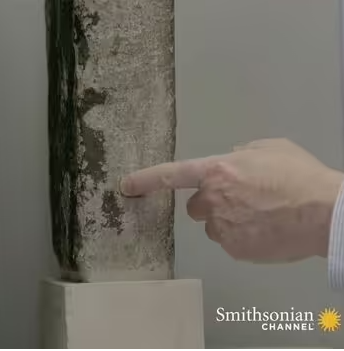 Babylone - Archaeologists have worked tirelessly at the site when given the opportunity, hoping to uncover more about the well-documented yet elusive site, with one previous excavation turning up "unusual construction material" discovered on a brick believed to have once been part of the famed Tower of Babel. The brick was commissioned by King Nebuchadnezzar II — the man who researchers believe ordered the tower's construction. This came back in 586 BC when he stormed Jerusalem and sought to make prisoners of its most highly skilled workers and educated citizens, the event explored during the Smithsonian Channel's documentary, 'Secrets Unlocked: Tower of Babel'. Once captured, these people were brought to Babylon and became slaves to the king and forced to build the now-famous tower.The brick archaeologists found carried traces of bitumen, an ancient tar, and mortar, a material mentioned in the biblical story that refers to the tower.Researchers know Nebuchadnezzar commissioned the brick because his name is inscribed on the front, its edge covered in a thick black substance that is the bitumen.
Babylone - Archaeologists have worked tirelessly at the site when given the opportunity, hoping to uncover more about the well-documented yet elusive site, with one previous excavation turning up "unusual construction material" discovered on a brick believed to have once been part of the famed Tower of Babel. The brick was commissioned by King Nebuchadnezzar II — the man who researchers believe ordered the tower's construction. This came back in 586 BC when he stormed Jerusalem and sought to make prisoners of its most highly skilled workers and educated citizens, the event explored during the Smithsonian Channel's documentary, 'Secrets Unlocked: Tower of Babel'. Once captured, these people were brought to Babylon and became slaves to the king and forced to build the now-famous tower.The brick archaeologists found carried traces of bitumen, an ancient tar, and mortar, a material mentioned in the biblical story that refers to the tower.Researchers know Nebuchadnezzar commissioned the brick because his name is inscribed on the front, its edge covered in a thick black substance that is the bitumen.
https://www.express.co.uk/news/science/1803380/archaeology-iraq-bible-story-spt
TUNISIE – 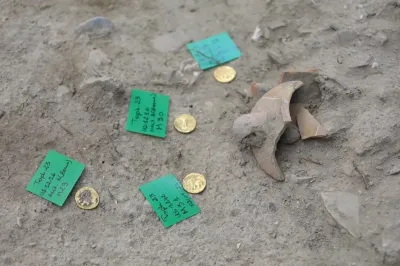
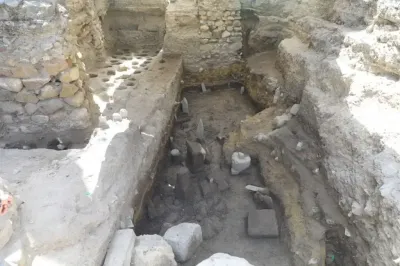 Carthage - Archaeologists excavating the sanctuary of Tophet, Carthage uncovered a collection of offerings, Tunisia’s Ministry of Cultural Affairs announced in a news release. They found five gold coins from the 3rd century BC, tombstones, and several urns with the remains of animals, infants, and premature babies. The Sanctuary Tophet in Carthage had a “shrine area” for the sacrificial offerings and a cemetery area where the deceased was then buried. The rare gold coins are about an inch in size and have a design showing the face of Tanit, an ancient goddess of fertility and motherhood, the Tunisian outlet Shems FM reported. The coins were left as offerings to the Tophet’s main deities, the god Hammon and the goddess Tanit, by wealthy worshippers, Arabic RT reported.
Carthage - Archaeologists excavating the sanctuary of Tophet, Carthage uncovered a collection of offerings, Tunisia’s Ministry of Cultural Affairs announced in a news release. They found five gold coins from the 3rd century BC, tombstones, and several urns with the remains of animals, infants, and premature babies. The Sanctuary Tophet in Carthage had a “shrine area” for the sacrificial offerings and a cemetery area where the deceased was then buried. The rare gold coins are about an inch in size and have a design showing the face of Tanit, an ancient goddess of fertility and motherhood, the Tunisian outlet Shems FM reported. The coins were left as offerings to the Tophet’s main deities, the god Hammon and the goddess Tanit, by wealthy worshippers, Arabic RT reported.
TURQUIE – 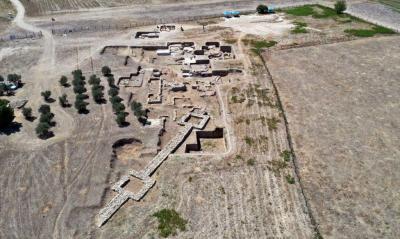
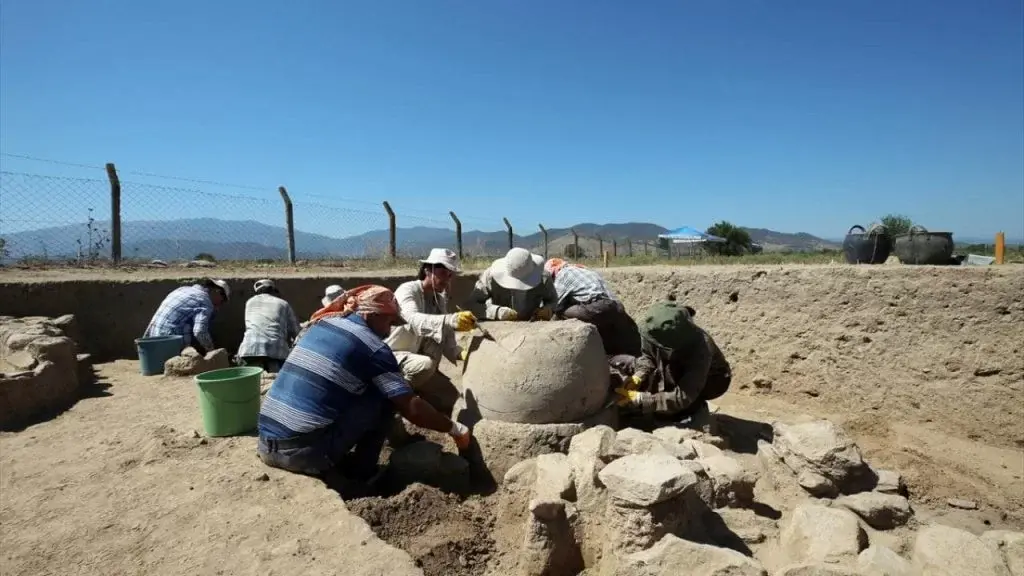 Tepecik - Excavations at Tepecik Mound in the Çine district of Aydın province, located in the western part of Turkey, revealed a structure believed to have been used as a palace or temple in the 13th century BCE, along with storage jars for grain. Çine Tepecik is located 5 km west of the town Çine in the province of Aydın. The settlement mound lies 600 m east from the present stream course of the Çine creek (Çine Çayı = the ancient river Marsyas) and 3 km southwest of the village Karakollar. This valley forms a strategic link to the Bay of Gökova and its natural ports. Excavations at Tepecik Mound, which is located among olive trees and cornfields on the Çine Plain, have been carried out under the presidency of Professor Sevinç Günel of Hacettepe University’s archaeology department since 2004. Three towers, a room containing items used by the rulers of the period for official visits, and obsidian used in tool making were discovered as part of the 17-year excavations at the archaeological site, which was known as a trade center in the past. Archaeologists also discovered a ceramic-tiled oven in the mound in 2021. Speaking to Anadolu Agency (AA), excavation head Günel said that the region hosted settlements back-to-back for 7,500 years. Günel stated that they excavated the settlement and cultural layers of the 2000s BC in the mound and that they found remains of architecture from the Late Bronze Age during the work in the south of the settlement. “The mound has a long-term settlement process and we are currently excavating the settlement culture layer of the second millennium BC. In this area, architectural remains from the 13th century BC (Late Bronze Age) surprised us with a magnificent wall structure and finds,” she said.“Unlike previous years, the structure is quite thick, has a splendid wall knitting technique, and is probably very large. According to our first predictions, it has an architecture that I can say belongs to a public building. Large jars associated with this structure were identified. These storage jars function completely as a warehouse. Therefore, I can say that we are currently working on a storage area belonging to a magnificent public structure,” she added. Stating that the building where the jars are located has different architectural features, Günel stated that structure reminds the remains of a building that has a special meaning such as a palace or temple architecture in Pre Asian archaeology, but it is too early to speak. She stated that he will be able to speak more precisely when the work progresses and that it is more correct to define the building as a public building for now. Pointing out that Tepecik was a trade center for obsidian and agricultural products used in the making of tools and weapons as a result of the excavations carried out in previous years, Günel noted that this year’s discoveries of the jars also suggest a storage system under local administration and point to a vibrant agricultural economy. The remains inside the jars, which are thought to belong to the period of Arzava or Mira Kingdom, a country affiliated to the Hittite Kingdom in 1350-1300 BC, will be subjected to archaeobotanical examination.
Tepecik - Excavations at Tepecik Mound in the Çine district of Aydın province, located in the western part of Turkey, revealed a structure believed to have been used as a palace or temple in the 13th century BCE, along with storage jars for grain. Çine Tepecik is located 5 km west of the town Çine in the province of Aydın. The settlement mound lies 600 m east from the present stream course of the Çine creek (Çine Çayı = the ancient river Marsyas) and 3 km southwest of the village Karakollar. This valley forms a strategic link to the Bay of Gökova and its natural ports. Excavations at Tepecik Mound, which is located among olive trees and cornfields on the Çine Plain, have been carried out under the presidency of Professor Sevinç Günel of Hacettepe University’s archaeology department since 2004. Three towers, a room containing items used by the rulers of the period for official visits, and obsidian used in tool making were discovered as part of the 17-year excavations at the archaeological site, which was known as a trade center in the past. Archaeologists also discovered a ceramic-tiled oven in the mound in 2021. Speaking to Anadolu Agency (AA), excavation head Günel said that the region hosted settlements back-to-back for 7,500 years. Günel stated that they excavated the settlement and cultural layers of the 2000s BC in the mound and that they found remains of architecture from the Late Bronze Age during the work in the south of the settlement. “The mound has a long-term settlement process and we are currently excavating the settlement culture layer of the second millennium BC. In this area, architectural remains from the 13th century BC (Late Bronze Age) surprised us with a magnificent wall structure and finds,” she said.“Unlike previous years, the structure is quite thick, has a splendid wall knitting technique, and is probably very large. According to our first predictions, it has an architecture that I can say belongs to a public building. Large jars associated with this structure were identified. These storage jars function completely as a warehouse. Therefore, I can say that we are currently working on a storage area belonging to a magnificent public structure,” she added. Stating that the building where the jars are located has different architectural features, Günel stated that structure reminds the remains of a building that has a special meaning such as a palace or temple architecture in Pre Asian archaeology, but it is too early to speak. She stated that he will be able to speak more precisely when the work progresses and that it is more correct to define the building as a public building for now. Pointing out that Tepecik was a trade center for obsidian and agricultural products used in the making of tools and weapons as a result of the excavations carried out in previous years, Günel noted that this year’s discoveries of the jars also suggest a storage system under local administration and point to a vibrant agricultural economy. The remains inside the jars, which are thought to belong to the period of Arzava or Mira Kingdom, a country affiliated to the Hittite Kingdom in 1350-1300 BC, will be subjected to archaeobotanical examination.
